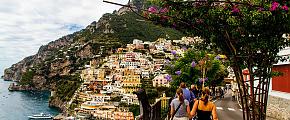10 Essential Italy Travel Tips for First Timers
For first-time visitors to Italy, there may be many things to prepare for, such as visas, currency, language, local customs, and more. This article aims to help backpackers traveling to Italy for the first time make adequate preparations in advance to fully enjoy this beautiful and delicious Italy tour.
Recheck Your Visa & Passport
Before departure, you may need to check the visa situation, as Italy is a member of the European Union and the Eurozone. Entering Italy, you may be required to have a valid Schengen visa.
However, citizens of certain countries or regions, such as the United States, Canada, Australia, and New Zealand, only need to prepare a valid passport and can stay for up to 90 days without a visa. Therefore, it is advisable to inquire about the latest visa information from the Italian embassy or consulate in your country before traveling.
Dress Appropriately for Sightseeing
Though the brilliant Italian sunshine makes sunglasses essential gear, a light jacket or sweater is also advisable to ward off any evening chills or cooler temperatures on planes and in air-conditioned spaces.
Bring pants or skirts that cover the knees, as you'll undoubtedly be visiting the country's magnificent churches. With the right versatile wardrobe, you'll be prepared to soak in all the magic of Bella Italia.
Prepare A Walking Tour
A walking tour is one of the best ways to intimately experience Italy's historic cities like Rome, Florence, Venice and beyond. Many of the most iconic sights and charming neighborhoods are compact and best explored on foot.
Walking tours allow you to go at a leisurely pace, duck into quaint piazzas, and soak in the surroundings. Some walking tours cover several miles over the course of a half or full day, so being prepared with proper footwear can make a major difference in your comfort and ability to fully enjoy the experience without foot fatigue or pain.
 Venice
Venice
Take Some Cash With You
Having some spare change on hand is essential when traveling in Italy, as there are a couple of classic scenarios where cash in coins is required. For example, many public restrooms have self-service turnstiles requiring €1 to pass through. Or if you spot a tempting gelato stand on the street, those decadent scoops will run you €2-5 in coins.
You don't need an exorbitant amount of change, however. Around €10 per day should suffice for small cash needs, as credit cards and mobile payment apps like Apple Pay are widely accepted elsewhere.
Tipping & Additional Charge
As a general rule, tipping in Italy is not required as a service charge is typically included in the bill when dining out. However, if you were particularly pleased with the service, it's customary to leave a little extra gratuity. One thing to note is that in Italian restaurants, you are normally charged for drinking water with your meal.
Additionally, if you partake in a local tour or guided excursion, it's common practice to tip your guide at the end, even if the tour itself was complimentary. A modest tip acts as a gesture of appreciation for their expertise and hospitality.
Check the Rule Book of Drinking
You must have seen words like "espresso", "Cappuccino", "affogato", and "barista", which are all come from Italian and related to coffee culture.
How could you visit Italy without savoring authentic Italian coffee? Cafés, bakeries, and restaurants throughout the country offer the perfect opportunity to indulge. Rather than oversized mugs, Italian coffee is traditionally served in smaller portions - allowing you to slowly sip and appreciate the rich aroma, rather than gulping it down in haste. You can enjoy an espresso at any time of the day, but a cappuccino is usually served at breakfast.
Take Advantage of Drinking Water Fountains
In Italian towns and cities, you'll frequently see public fountains called 'nasoni' that provide cool drinking water for passersby, especially plentiful in cities like Rome. The nasoni are typically made of stone or bronze, standing alone on streets or as part of larger fountain sculptures. People can cup their hands or use bottles to drink from the spouts protruding like 'big noses'.
Learn A Little Italian
Upon arriving in Italy, the words you're likely to hear most often are "ciao" and "grazie" - the all-purpose Italian greetings for hello/goodbye and thank you, respectively. Ciao doubles as both a greeting and farewell, allowing you to warmly greet new Italian friends with one versatile word. Express gratitude to accommodating locals with a cheerful "grazie!" After mastering these two essentials, you'll feel instantly more at home.
When navigating towns, keeping an eye out for "duomo" ensures you never miss an opportunity to admire Italy's magnificent domed churches. And a "piazza" is guaranteed to lead you to one of the country's iconic open-air gathering places, ideal for people-watching over a cappuccino or gelato.
Be Alert to Travel Traps
When traveling in Italy, it's wise to be wary of potential travel traps. At famous attractions like the Vatican Museums, you may encounter individuals dressed officially with "credentials" who approach you in the queue. They'll claim the line is too long to ever get in and try to sell you their "skip the line" tickets. Be very cautious - these are likely unlicensed touts taking advantage of unsuspecting tourists.
Safeguarding your valuables is also crucial while in Italy. Never leave phones or wallets in open pockets or bags, and avoid allowing your belongings out of your sight, as skilled pickpockets work the crowds. A little vigilance can prevent an unwanted theft incident from derailing your Italian adventure.
 Vatican Museums
Vatican Museums
Be Patient for the Line
Traveling in Italy often requires patience in two aspects. Firstly, you need to be patient while waiting for dining or queuing to enter attractions. Secondly, public transportation may not always adhere to the timings suggested by your Google Maps, so if you're taking a bus or subway, you might need to patiently wait.
Related Posts You May Like
What Our Clients Say
Explore the latest verified reviews of Odynovo's travel services on Tripadvisor, Google, Trustpilot, Product Review and more trusted platforms.












